Top Photo: Fruit of Euonymus fortunei or winter creeper.
I happened to be walking through Into the Mist just as Exhibit Developer, Michele Kloda and Landscape Supervisor, Christian Britt were installing steps on one of the tunnel mounds in that much visited playscape. Michele pointed to a vine growing up one of the black locust trees in the exhibit and suggested “bittersweet.”
Glancing at the many red fruit dangling from the vine, and frankly, not knowing any better, I said, “yes, I think it is.”
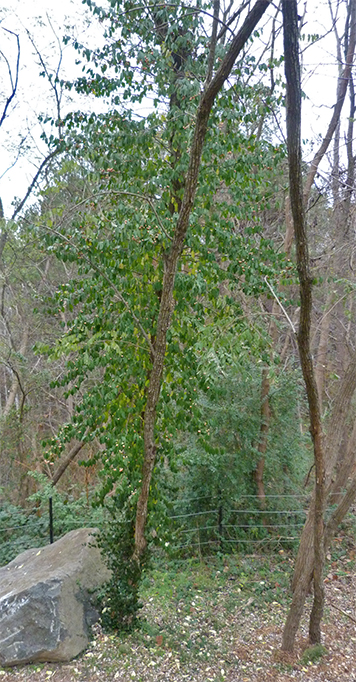
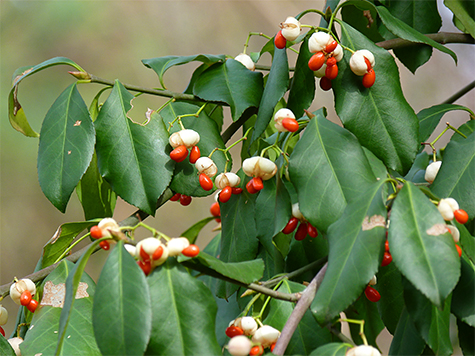
There was something wrong, though, with this identification. The leaves on the vine were opposite. Bittersweet’s leaves are alternate. Opposite leaves grow opposite one another on the branch or twig, whereas alternate leaves grow alternately on the twig, one leaf on the left side, a little further up the twig and another leaf grows on the right side of the twig.
Another characteristic which was puzzling was the fact that the fruit stalks arose from the leaf axil, the spot where the leaf stem meets the twig. This is not a characteristic of bittersweet.
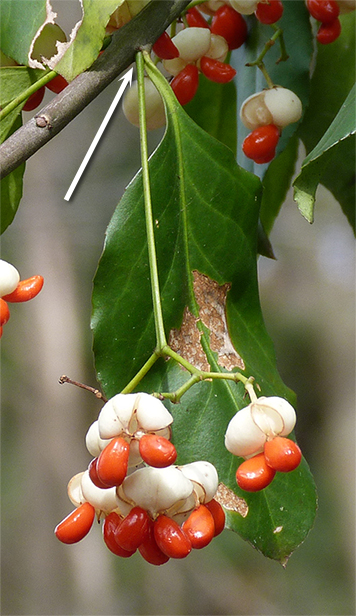
I’d seen this before. The flower stalks, and therefore the fruit stalks, emanate from the leaf axil in strawberry bush.
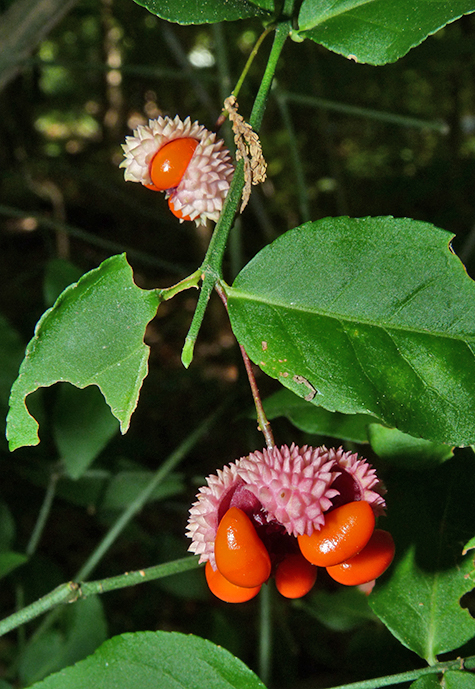
Note the opposite leaves and the point at which the fruit stalk attaches in the photo of strawberry bush above. The fruit themselves are even similar.
I still, however, didn’t know what the plant was. I was still trying to make it into some kind of bittersweet, whether American, Asiatic, or a hybrid of the two.
I showed a cutting of the plant to Richard Stickney of the Butterly House Conservatory here at the Museum, a good person to go to with an unidentified plant. The first thing Richard said to me was euonymus. Bittersweet is not an euonymus. Strawberry bush is an euonymus, Euonymus americanus, to be exact. But this was no strawberry bush.
Through much searching, I narrowed it down to Euonymus hamiltonianus or Euonymus fortunei. Neither, by the way, is native to our area, originating in Asia, and both are considered invasive.
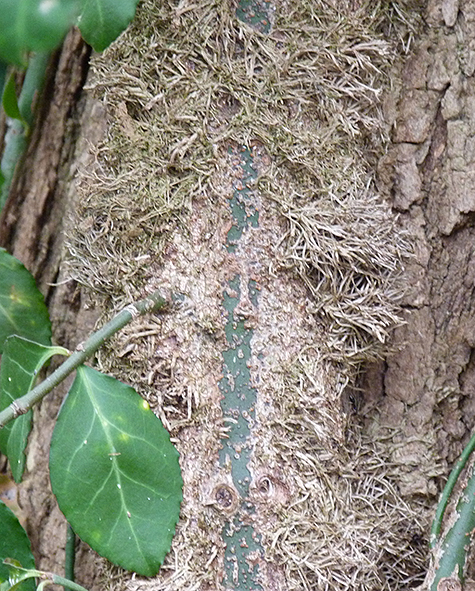
Most plants in the genus euonymus are shrubs or small trees. One important consideration here, and you may have noticed, is that this is a vine, growing poison ivy-like up the side of a tree. Fortunei is sometimes called winter creeper. It’s a vine while the hamiltonianus, or Hamilton’s spindle tree (Hamilton’s spindle, or Himalayan spindle) usually grows as a shrub or small tree. I’m fairly confident that the vine in question is winter creeper, or some cultivar of that plant.
How did the plant get where it is, growing up the side of a locust tree, at the Museum of Life and Science in Durham, North Carolina?
The original of this vine in Into the Mist was, or is, probably in someone’s garden. They are, as mentioned, cultivated. But how did it get here, in Into the Mist? Birds will and do eat the vine’s seeds (they’re toxic to humans). Perhaps a bird visiting the garden where the original plant was, or is still growing, ate one or several of the fruit. Passing by the Museum, the bird landed in one of the locust trees, depositing seeds in it’s droppings beneath the tree. The vine sprang up where the seed laced droppings fell.
Perhaps a seed was brought to us in mulch or fill dirt during the developing of Into the Mist. However it got here, it’s here and is growing quite well. Stop and have a look at it while you visit Into the Mist on your next trip through Catch the Wind. It’s just to the right of the cob (small hut made of straw, sand, and clay) at the back of the playscape.
By the way, the plants within the genus euonymus are in the same family as bittersweet, Celastraceae.
I’m in Missouri and I’ve been desperately seeking the name of what I believe now to be euonymus fortunei. Although when I have found a matching image of the berries they have differing names. They are not winterberry. I think your photo may be incorrect as well as I’ve seen that photo named pink lady.
I’d like to send you a photo of the trees (and they are a row of trees, not vines) my berries are exactly like your image entitled “the fruit of the vine”. Except it’s not a vine! I’ve managed to root a cutting and a single leaf!!! The new owners of the property are poisoning them so I need to find plants to buy so I can have a beautiful privacy screen when they succeed. As far as them being invasive, I’ve lived across from them since 1985 and they haven’t spread one inch! And they haven’t vined up the tree of heaven right next to them.
I’d love your opinion on this if possible. There’s so much incorrect and conflicting info online I don’t know who to believe.
I am in Louisville Kentucky and have this on my tree as well
I I’m in the Ozarks in Missouri and I’m pretty sure I just found exactly what you’re talking about. It is an old walnut tree that looks to be dying or dead and a creeping vine all up at that now has plumed and blossomed with green leaves and white berry looking things but on the inside are actual red berries.
Will the museum be killing this invasive before it can spread? In general, how does the museum handle invasives?
The official word from the Director of Landscaping here at the Museum is that “We remove invasives as time and labor permits.” With 84 some acres to manage, you can imagine that’s quite a chore.
I myself, often clip any invasive I notice in my wanderings around the grounds.
Thanks for your comment/inquiry.
Do it quick. I live in southern Illinois, and this Euonymus is everywhere, gradually sucking the life out of all the huge old trees in town. It kills them, and when we have big storms, the trees fall apart and large limbs do massive damage. There is not a tree in the neighborhood that doesn’t have some degree of growth on it currently, it spreads that thoroughly. It also grows as underbrush, choking out any other plants trying to grow in beds, borders, etc. It is very hard, almost impossible, to remove completely once established.